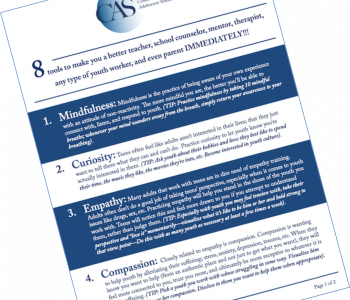

Sam Himelstein, PhD
Sam Himelstein is the founder and CEO of the Center for Adolescent Studies, Inc. He is passionate about working with youth and training the professionals that serve them.
Teaching meditation to teens who have the giggles
Teaching mindfulness to teenagers is one of my favorite professional pastimes. I usually teach mindfulness to young people in educational, medical, and even correctional settings. To say the least, the teens themselves aren’t always that excited about closing their eyes and meditating in front of their peers, especially if they have a negative connotation toward meditation.
I’ve seen youth look around the room with that “what the fuck?” look on their face for social confirmation among their peers, to teens laughing immediately and uncontrollably right after ringing the bell to start, to everything in between.
If you’re reading this blog post you’ve probably been there too. You’re all ready and set with a killer lesson plan, excited to share how profoundly mindfulness has impacted your life, and well, they’re just in too playful of a mood to meditate. Sometimes youth I work with are downright resistant about meditation, but that happens much less than most people would think.
I get asked all the time while teaching at conferences and trainings,
“How do you do it?”
“How do you get teenagers to meditate? How do you get youth involved in gangs, youth who are incarcerated, youth who’ve been traumatized to practice meditation?”
“Buy my book” I jokingly respond.
I then follow up with the truth: treat someone like a human being, build a relationship, and it’s amazing what you can “get them to do.”
The fact is however, that even when you have a relationship that’s strong sometimes teens don’t want to meditate. That peer-to-peer social influence can be strong, and if one person in the group is a little uncomfortable with meditation and wants to use humor to ease their mood, you can bet that more often than not the rest of the group will follow (especially if the youth all know each other).
This begs the question for us mindfulness facilitators: What should we do if we want to teach mindfulness but our teens are just too playful to meditate?
Play the Mindfulness game: “Still Chillen”
Still Chillen is a game that was developed by the Mind Body Awareness (MBA) Project years ago while I was working with them. Vinny Ferraro, the former training director and a friend and mentor of mine coined the name “still chillen,” after we’d all been talking about the parameters of the game and how it could be used to facilitate aspects of mindfulness.
Next time the youth in your group or class are just too humorous or giggly, don’t force the issue about meditating. Remember, treat them like human beings and the sky’s the limit on what you can accomplish. That means not flexing your authority as an adult when they’re just doing what teens naturally do when they’re a little uncomfortable with meditation (or just in a silly mood). Next time that happens, simply state that you have a game that may be more in alignment with the energy of the room and ask if they’d like to play.
Then explain Still Chillen. Here are the game parameters:
- Everybody sits in a circle (preferably)
- The game is a competition and the object of the game is to be the last person “still chillen” (i.e., not moving and staying still)
- You (the facilitator) will be charged with watching the youth and calling them “out” once they move
- They are allowed to breath and blink (and keep their eyes closed if they wish), but they need to keep their face up and visible
- Once out they should sit quietly
- You will call folks out until there is a sole winner
- Repeat for a total of 3 rounds with the below prompts in between rounds one and two and two and three
Before you start: Explain the game to the group and encourage them to stretch and get the “giggles” out. Then countdown from three and ring your meditation bell signifying the start of the game. You’ll probably see a bunch of youth start laughing immediately. That’s fine. Call them out. Wait until you get down to your last two and then start narrating the experience: “…it’s down to John and Kim … Looks like this one is going down to the wire … don’t let anyone else get you off your center … etc.” I especially like to do that with youth who are doing really well, to see if a little pushing will get them to laugh. Once someone wins, ask the group if they’d like to play another round. They’ll likely say yes.
Between the first and second round: After this round, explain that you simply want them to set one intention for this second round: to stay still longer than the last round, even if just slightly.
Most likely they’ll be able to stay still and quiet longer. Sometimes it’s a little longer (i.e., seconds), and sometimes a lot longer.
Before moving on to the next round, ask the youth who’ve won or stayed still close to the end to discuss how they were able to stay still. Some of the following questions may be helpful.
“What did you do with your mind?”
“Did you focus on one thing?”
“Push everything out of your mind?”
“Go to another place?”
Have a few youth discuss this openly to give other youth ideas about self-regulation.
Give the group a heads up to get their giggles out and stretch again, and then ring the bell to signify round two. Go through the round until you get another winner (which could be the same person).
Between the second and third rounds: Then, prior to starting the third and final round, state that you’d like the group to follow two intentions for the last round: 1) go longer than the last round, and 2) focus on your breath to not get distracted by anyone else. Then proceed with round three.
And voilá! Over half the time in my experience, the group becomes still, silent, and calm. A few minutes go by and no one gets called out. Sometimes five, six, or even seven minutes. Sometimes they forget they’re in a game. They’re just meditating.
Since I don’t like the idea of “manipulating” anyone into meditation, I inevitably start messing with the group to start getting youth out; narrating and edging them on (remember, it is usually a humorous atmosphere). When you’re done, start a dialogue about how this game relates to meditation and mindfulness.
You might ask things like:
“How does staying still relate to meditation?”
“Do you think the skill of sitting still can help you in any areas of life? If so, what?”
“What’s the relationship between mindfulness and self-regulation?”
“In your life right now, where could you use more of an ability to regulate yourself?”
Still Chillen is just one way to meet the energy of the room; a necessary skill for mindfulness facilitators. That’s not to say that you can’t gently challenge youth to meditate at times, but that’s for another post. I’ve facilitated Still Chillen possibly close to 1000 times and still keep it in my tool belt as a way to promote self-regulation and awareness when needed.
Trust me, the youth you work with will ask for it again in the future and appreciate your ability to mix up the way in which you teach mindfulness. This will contribute to you building authentic relationships and ultimately influence more receptivity from and better outcomes for the youth you work with.

